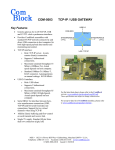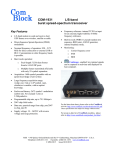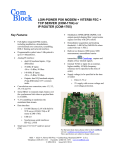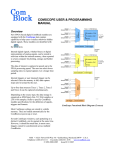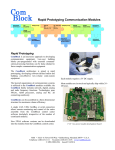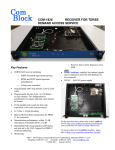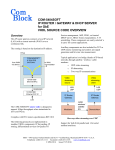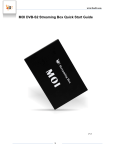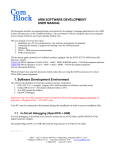Download 138 KB - ComBlock
Transcript
COM-1010 CONVOLUTIONAL ENCODER Key Features • • • • • • • • • • Convolutional encoder for error correction. Selectable rate and constraint length: K = 5, rate 1/7 K = 7, rates ½, 2/3, ¾, 5/6, 7/8 K = 9, rates 1/3, ½, 2/3 Treillis Coding Modulation (TCM) encoder: Rate 2/3 (8-PSK) Rate ¾ (16-PSK) Continuous or Block mode operation. Support for the following standards: Intelsat IESS-308/309 Intelsat IESS-310 DVB ETS 300 421 DVB ETS 300 744 CCSDS 101.0-B-6 Differential encoder. Maximum throughput (at output): 40 Mbps. On-board or external clock selection. Electrical Interface Input Module Interface Definition DATA_IN SAMPLE_CLK_IN Input data stream Input signal sampling clock. One CLK-wide pulse. Read the input signal at the rising edge of CLK when SAMPLE_CLK_IN = ‘1’. One CLK-wide pulse output. Requests a sample from the module upstream. For flowcontrol purposes. Optional start of frame reset input. Used only in block mode. Ignored in continuous mode. 1 CLK-wide pulse. Aligned with SAMPLE_CLK_IN. Input reference clock for synchronous I/O and processing. Yields internal CLK clock. Maximum frequency fclk is 40 MHz. Definition SAMPLE_CLK_IN_REQ SOF_RESET ComScope –enabled: key internal signals can be captured in real-time and displayed on host computer. Single 5V supply. Connectorized 3”x 3” module for ease of prototyping. Standard 40 pin 2mm dual row connectors (left, right, bottom). Interfaces with 5V and 3.3V logic. For the latest data sheet, please refer to the ComBlock web site: www.comblock.com/download/com1010.pdf. These specifications are subject to change without notice. For an up-to-date list of ComBlock modules, please refer to www.comblock.com/product_list.htm . CLK_IN Output Module Interface DATA_OUT[3:0] Output data stream. Can be one-bit serial, 2/3/4 bit parallel depending on the format selection. 2-bit parallel typically used for I/Q QPSK modulation. 3-bit parallel typically used for 8-PSK modulation. 4-bit parallel typically used for 16-PSK modulation. MSS • 18221 Flower Hill Way #A • Gaithersburg, Maryland 20879 • U.S.A. Telephone: (240) 631-1111 Facsimile: (240) 631-1676 www.ComBlock.com © MSS 2000-2006 Issued 1/14/2006 SAMPLE_CLK_OUT SAMPLE_CLK_OUT_REQ Serial Monitoring & Control Power Interface Output symbol clock. One CLK-wide pulse. Read the output signals at the rising edge of CLK when SAMPLE_CLK_OUT = ‘1’. One CLK-wide pulse input. Requests for a sample from the module downstream. For flow-control purposes. DB9 connector. 115 Kbaud/s. 8-bit, no parity, one stop bit. No flow control. 4.75 – 5.25VDC. Terminal block. Power consumption is approximately proportional to the CLK frequency. The maximum power consumption at 40 MHz is 300mA. Output sample format Internal pattern generation (test mode) Complete assemblies can monitored and controlled centrally over a single serial or LAN connection. The test pattern bit rate is automatically set by the external sink module (typically a modulator) as part of the flow control mechanism. The module configuration parameters are stored in non-volatile memory. All control registers are read/write. Constraint length K and rate R Differential Encoding Continuous / Block mode Configuration 0000 = (K=5, R=1/7) 0001 = (K = 7, R=1/2, Intelsat) 0010 = (K = 7, R=2/3, Intelsat) 0011 = (K = 7, R=3/4, Intelsat) 0100 = (K = 7, R=5/6, Intelsat) 0101 = (K = 7, R=7/8, Intelsat) 0110 = (K = 9, R=1/3) 0111 = (K = 9, R=1/2) 1000 = (K = 9, R=2/3) 1001 = (TCM, K=7, R=2/3) 1010 = (TCM, K=7, R=3/4) 1011 = (K = 7, R=1/2, CCSDS) 1100 = (K = 7, R=2/3, CCSDS) 1101 = (K = 7, R=3/4, CCSDS) 1110 = (K = 7, R=5/6, CCSDS) 1111 = (K = 7, R=7/8, CCSDS) REG0 bits 4-1 0 = disabled 1 = enabled REG0 bit 5 Determines whether the SOF_RESET mode should be enabled for resetting the encoder at the start of a block. 0 = continuous 01 = counting sequence: When set, the baseband input is disabled and a periodic pattern is internally generated at the encoder input. The pattern consists of an 8-bit counter, MSB transmitted first. 10 = PRBS-11. internal generation of 2047-bit periodic pseudo-random bit sequence as modulator input. (overrides external input bit stream). Useful in measuring BER performances in conjunction with COM-1005. Configuration (via Serial Link / LAN) Parameters 1 = block mode. REG0 bit 6 00 = 1 bit serial 01 = 2 bit parallel (I/Q) for connection to QPSK modulator. 10 = 3-bit parallel for connection to 8PSK modulator. 11 = 4-bit parallel for connection to 16PSK modulator This field is ignored when TCM mode is selected. REG1 bits 1-0 00 = test mode disabled Output symbol rate internal / external selection REG1 bits 3-2 In most cases, the COM-1010 throughput is determined by modules downstream (for example a modulator). There are, however, cases when the throughput is set using an internal NCO (for example when testing convolutional encoder and Viterbi decoder back to back). 0 = exter nal. Output symbol rate is based on SAMPLE_CLK_OUT_REQ samples requests from following module. 1 = internal. Output symbol rate is selected internally by the NCO frequency set in REG2/3/4. Sample requests SAMPLE_CLK_OUT_REQ are ignored. Output symbol rate NCO REG1 bit 4 Internal generation of the output symbol rate. Ignore this field when the output symbol rate is determined by modules downstream. 24-bit signed integer (2’s complement 2 representation) expressed as fsymbol rate * 224 / fclk. The internal processing clock fclk is typically 40 MHz. REG2 = bits 7-0 (LSB) REG3 = bits 15 – 8 REG4 = bits 23 – 16 (MSB) Baseline configurations can be found at www.comblock.com/tsbasic_settings.htm and imported into the ComBlock assembly using the ComBlock Control Center File | Import menu. Monitoring (via Serial Link / LAN) Monitoring registers are read-only. Parameters Option o / Version v Monitoring Returns ‘1010ov’ when prompted for option o and version v numbers. Key internal signals can be captured in real-time and displayed on a host computer using the ComScope feature of the ComBlock Control Center. The COM-1010 signal traces and trigger are defined as follows: Format 1: Input bit stream or test pattern Binary 2:Output symbol request (internally set by NCO or externally by SAMPLE_CLK_ OUT_REQ) Trace 2 signals 1: Input bit clock Binary 2: Output bit stream DATA_OUT(0) Trace 3 signals Binary Format 1: Binary clock fclk Binary SAMPLE_CLK_OUT Trigger Signal 1: Start of internal PRBS11 test sequence 2: SOF_RESET processing clock fclk 4096 Format binary binary Signals sampling rates can be changed under software control by adjusting the decimation factor and/or selecting the fclk processing clock as realtime sampling clock. In particular, selecting the fclk processing clock as real-time sampling clock allows one to have the same time-scale for all signals. The ComScope user manual is available at www.comblock.com/download/comscope.pdf. Test Points ComScope Monitoring Trace 1 signals SAMPLE_CLK_ IN_REQ 2: Nominal sampling rate 1 sample /bit Buffer length (samples) 4096 Binary processing clock fclk 4096 Format Nominal sampling rate processing clock fclk 1 sample/bit Capture length (samples) 4096 Nominal sampling rate processing Capture length (samples) 4096 Test points are provided for easy access by an oscilloscope probe. Test Point Definition TP1 TP2 TP3 TP4 TP5 Input serial stream bit clock Input serial stream data Output serial stream bit clock Output serial stream data Start of the periodic LFSR-11 2047-bit test pattern. 4096 3 G0 = 171 octal Implementation K=5 The generator polynomials for K = 5 R = 1/7 is G0(x) = 1 + x + x2 + x4 G1(x) = 1 + x2 + x3 + x4 G2(x) = 1 + x2 + x4 G3(x) = 1 + x2 + x3 + x4 G4(x) = 1 + x + x3 + x4 G5(x) = 1 + x + x2 + x4 G6(x) = 1 + x + x2 + x3 + x4 G1 = 133 octal Basic CCSDS convolutional encoder The basic encoder inverts the G1 output. When using puncturing, this inverter is removed. Puncturing G0 = 171 octal K = 7 (Intelsat) The generator polynomials for K = 7 R = ½ are G0(x) = 1 + x2 + x3 + x5 + x6 G1(x) = 1 + x + x2 + x3 + x6 133(octal) and 171(octal). The implementation is depicted below: D D D D D D D Puncturing G0 = 133 octal G1 = 171 octal G1 = 133 octal CCSDS convolutional encoder with puncturing Rates other than ½ are implemented by puncturing the rate ½ encoded data stream. The puncturing pattern is as follows (1 denotes transmission, 0 blocking) Rate 2/3 G0 10 G1 11 Rate ¾ G0 101 G1 110 Rate 5/6 G0 10101 G1 11010 Rate 7/8 G0 1000101 G1 1111010 Rates other than ½ are implemented by puncturing the rate ½ encoded data stream. The puncturing pattern is as follows (1 denotes transmission, 0 blocking) Rate 2/3 G0 11 G1 10 Rate ¾ G0 110 G1 101 Rate 5/6 G0 11010 G1 10101 Rate 7/8 G0 1111010 G1 1000101 The generator polynomials for K = 9 R = 1/3 are G0(x) = 1 + x2 + x3 + x5 + x6 + x7 + x8. G1(x) = 1 + x + x3 + x4 + x7 + x8. G2(x) = 1 + x + x2 + x5 + x8. K = 7 (CCSDS) K = 9 R = ½, 2/3 The generator polynomials for K = 7 R = ½ are G0(x) = 1 + x + x2 + x3 + x6 G1(x) = 1 + x2 + x3 + x5 + x6 171(octal) and 133(octal). The implementation is depicted below: The generator polynomials for K = 9 R = 1/2 are G0(x) = 1 + x + x2 + x3 + x5 + x7 + x8. G1(x) = 1 + x2 + x3 + x4 + x8. K = 9 R = 1/3 The rate 2/3 is implemented by puncturing the rate ½ encoded data stream. The puncturing pattern is as follows (1 denotes transmission, 0 blocking): Rate 2/3 G0 11 G1 01 4 This is the case, for example when the reference real-time clock is the modulation rate. By ‘pulled’, we mean that the data processing is going downstream, whereby the clock requests are going in the opposite direction. Differential Encoding Differential encoding can be used prior to FEC encoding as specified in Intelsat IESS-308/309. This feature can be enabled/disabled by software. D Treillis Coded Modulation (TCM) Encoder As per Intelsat IESS-310 for rate 2/3 8-PSK. differential encoder 1 I 1:2 Demux differential encoder 2 Timing Q D D D In order to cater to this requirement, the COM-1010 module includes a built-in numerically controlled oscillator which generates the SAMPLE_CLK_IN_REQ output based on the SAMPLE_CLK_OUT_REQ input. For example, if a rate ¾ puncturing is selected together with a 1-bit serial output, the NCO will generate 3 SAMPLE_CLK_IN_REQ output pulses for every 4 SAMPLE_CLK_OUT_REQ input pulses. D D D D The I/O signals are synchronous with the rising edge of the reference clock CLK (i.e. all signals transitions always occur after the rising edge of the reference clock CLK). The maximum CLK frequency is 40 MHz. R D differential encoder Input TCM encoder, rate 2/3 for 8-PSK Input read at rising edge of CLK differential encoder 1 I CLK SAMPLE_CLK_IN differential encoder 2 DATA_IN differential encoder 3 Q differential encoder 4 Output CLK 1:3 Demux SAMPLE_CLK_OUT R DATA_OUT(0) 2 bits 2 bits 1 1 0 1 Output timing example: rate 1/2, serial output mode 2 output bits for every input bit. 02005801.dsf D D D D D D D S D differential encoder TCM encoder, rate 3/4 for 16-PSK Flow Control Output samples can be bursty, depending on the FEC rate selected. The diagram above illustrates the output sampling clock for rate R = ½., serial output mode The next ComBlock module recognizes that multiple output bits are sent in each burst as it reads the output at the rising edge of CLK when SAMPLE_CLK_OUT = ‘1’. In most applications, the data samples are ‘pulled’ from the end module which is the timing reference. 5 Mechanical Interface 5VDC Power Terminal Block, 90 deg corner (3.000", 3.000") Output Connectors J3, J4 A1 +5V GND GND U1 +3.3V Mounting hole (2.840", 2.840") P1 A1 pin (0.100", 2.250") A1 B1 B1 A1 Top view J2 Input signals 2 rows x 20 pin female, 90 deg 1 CLK_OUT DATA_OUT(0) DATA_OUT(2) SAMPLE_CLK_OUT DATA_OUT(1) DATA_OUT(3) GND SAMPLE_CLK_OUT_REQ A20 B20 B20 A20 Mounting hole (0.160",0.160") A1 pin (2.900", 2.250") Output A 2 rows x 20 pin male, 90 deg J3 B1 Mounting hole (0.160",2.840") Serial Link DB-9 Female 90 deg, DCE TP 10 J4 B20 A20 Output B 2 rows x 20 pin male, 90 deg Corner(0.000", 0.000") GND B1 A1 Mounting hole (2.840", 0.160") GND A1 pin (2.250", 0.100") Mounting hole diameter: 0.125" A1 pin height: 0.039" 01001702.dsf Maximum height 0.500" M&C TX JTAG TDO JTAG TCK M&C RX JTAG TMS GND A20 B20 Pinout I/O Compatibility List Serial Link P1 The DB-9 connector is wired as data circuit terminating equipment (DCE). Connection to a PC is over a straight-through cable. No null modem or gender changer is required. 5 1 9 6 DB-9 Female 2 Transmit 3 Receive 5 Ground Input Connector J2 (not an exhaustive list) Input Output COM-5003 COM-1002 BPSK/QPSK/OQPSK TCP-IP / USB digital modulator Gateway COM-1006 COM-1012/1019 DSSS digital Reed-Solomon modulator encoder COM-1028 FSK/MSK/GFSK/GMSK digital modulator COM-1023 BER generator, Additive White Gaussian Noise Generator COM-1009 Viterbi decoder (back to back) B1 A1 CLK_IN DATA_IN SAMPLE_CLK_IN ComBlock Ordering Information GND SOF_RESET COM-1010 SAMPLE_CLK_IN_REQ GND GND M&C RX JTAG TDI JTAG TCK Convolutional Encoder MSS • 18221 Flower Hill Way #A • Gaithersburg, Maryland 20879 • U.S.A. Telephone: (240) 631-1111 Facsimile: (240) 631-1676 E-mail: [email protected] M&C TX JTAG TMS GND A20 B20 6







